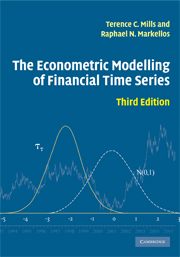Book contents
- Frontmatter
- Contents
- List of figures
- List of tables
- Preface to the third edition
- 1 Introduction
- 2 Univariate linear stochastic models: basic concepts
- 3 Univariate linear stochastic models: testing for unit roots and alternative trend specifications
- 4 Univariate linear stochastic models: further topics
- 5 Univariate non-linear stochastic models: martingales, random walks and modelling volatility
- 6 Univariate non-linear stochastic models: further models and testing procedures
- 7 Modelling return distributions
- 8 Regression techniques for non-integrated financial time series
- 9 Regression techniques for integrated financial time series
- 10 Further topics in the analysis of integrated financial time series
- Data appendix
- References
- Index
7 - Modelling return distributions
Published online by Cambridge University Press: 05 June 2012
- Frontmatter
- Contents
- List of figures
- List of tables
- Preface to the third edition
- 1 Introduction
- 2 Univariate linear stochastic models: basic concepts
- 3 Univariate linear stochastic models: testing for unit roots and alternative trend specifications
- 4 Univariate linear stochastic models: further topics
- 5 Univariate non-linear stochastic models: martingales, random walks and modelling volatility
- 6 Univariate non-linear stochastic models: further models and testing procedures
- 7 Modelling return distributions
- 8 Regression techniques for non-integrated financial time series
- 9 Regression techniques for integrated financial time series
- 10 Further topics in the analysis of integrated financial time series
- Data appendix
- References
- Index
Summary
The choice of unconditional distribution is something that has always puzzled academics and practitioners in finance. The standard assumption since the 1960s has been that financial prices are geometric Brownian motions and, therefore, logarithmic returns follow a normal distribution. This assumption has profound implications for a variety of theoretical and practical problems in finance, as expected returns and risks in a multivariate normal financial world can be fully described probabilistically using just means, variances and covariances. Much of finance analysis, such as primary and derivative asset pricing, portfolio optimisation and risk management, is built upon the assumption of normally distributed returns. The normal distribution also has important implications for econometric and statistical analysis, since most of the underlying theory is parametric and has been developed on the basis of normality.
The popularity of the normal distribution is easily justifiable from a practical point of view because it offers tractability and computational simplicity. Furthermore, the normality assumption is supported theoretically by the central limit theorem (CLT), which states that the sum of iid random variables with finite mean and variance will asymptotically converge to a normal distribution. Under these assumptions, the normal distribution will offer the best approximation to empirical return distributions in samples of reasonable size.
- Type
- Chapter
- Information
- The Econometric Modelling of Financial Time Series , pp. 247 - 273Publisher: Cambridge University PressPrint publication year: 2008



